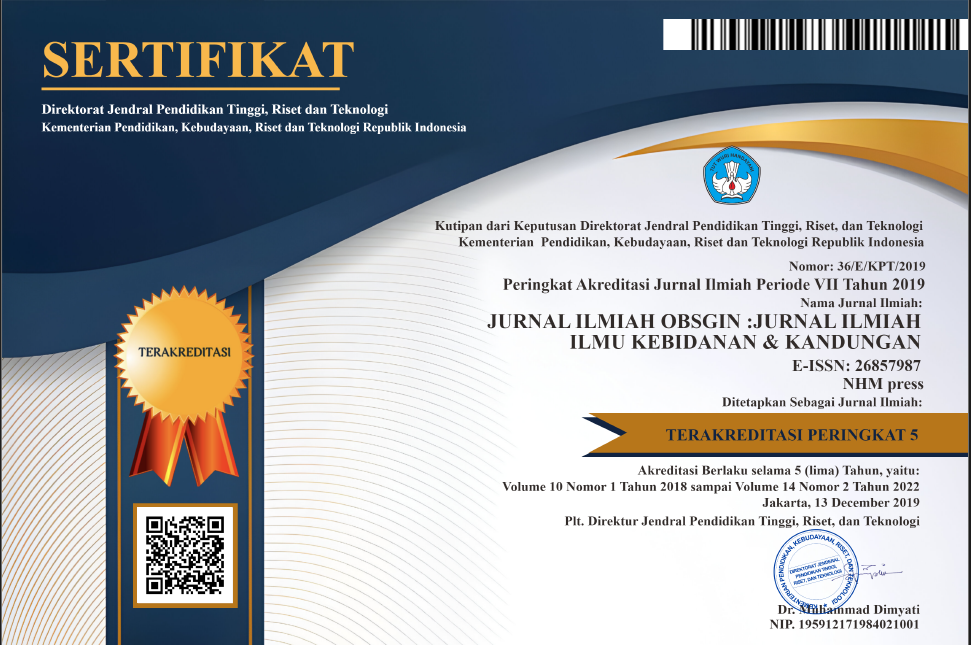HUBUNGAN PENGUNAAN KONTRASEPSI 3 BULAN DMPA DENGAN KENAIKAN BERAT BADAN DI TPMB ANNI LISTIAWATI
Abstract
Injectable birth control is the most widely used form of birth control. Injectable birth control contains the hormone progesterone or a combination of the hormone estrogen progesterone. The 3-month injectable contraceptive type DMPA (depo medroxy progesterone acetate) is highly effective but has several side effects. One of the side effects that can result from using injectable birth control is weight gain. Generally, the increase in body weight is not too large, varying between less than 1 kg - 5 kg in the first year of use. Objective: To determine the relationship between the use of 3 month DMPA injection contraception and weight gain at TPMB Anni Listiawati. Method: This research uses correlational analysis with a cross sectional design. The research population was 58 3-month DMPA contraceptive acceptors at TPMB Anni Listiawati Researchers used the Total Sampling technique with a sample size of 58 people. Results: The research showed that there was a significant relationship between the use of 3-month DMPA contraceptive contraceptives and the weight gain of injectable contraceptive acceptors. The results of the Chi-Square test obtained a p-value of 0.000 < 0.05, meaning that H1 was accepted, there was a relationship between the use of 3-month DMPA contraception and weight gain at TPMB Anni Listiawati, Lumajang City. Family planning acceptors are expected to pay more attention to its benefits,
advantages and side effects of the contraception to be used. It is recommended that health workers be more active in providing health education to the public, especially to mothers who are prospective family planning acceptors about the types, benefits, advantages, disadvantages and side effects of contraception.
References
Ajeng Retno Sari Dewi Sri Utari(2021). Hubungan KB Suntik DMPA Dengan Perubahan Berat Badan Di BPM Sri Sulasmi Sragen. Program Studi S1 Kebidanan, Fakultas Kesehatan Universitas Ngudi Waluyo
BKKBN. (2015). Keluarga Berencana dan Kesehatan Reproduksi. Jakarta: Badan Koordinasi Keluarga Berencana Nasional
DataBPS(Badan pusat stastistik) (2022) https://jatim.bps.go.id/statictable/2021/09/14/2284/jumlah-pasangan-usia-subur-dan-peserta-kb-aktif-menurut-kabupaten-kota-di-provinsi-jawa-timur-2020.html
Diakses 30 september 2023
Dewi Purba & Basaria Manurung (2022). Hubungan Penggunaan KB Suntik 3 Bulan Dengan Kenaikan Berat Badan Pada Wanita Usia Subur Di Puskesmas Maga Kabupaten Mandailing Natal. Jurnal Inovasi Riset Ilmu Kesehatan Vol. 1, No. 1 Februari 2023
Dian Purnama Sari (2021) . Efek Samping Pemakaian Kb Suntik 3 Bulan Pada Akseptor Di Bidan Praktik Swasta (Bps) Hj. Norhidayati Banjarmasin. Vol 6 No 2 (2021): Jurnal Keperawatan Suaka Insan (JKSI)
https://journal.stikessuakainsan.ac.id/index.php/jksi/article/view/297.Diakses 30 september 2023
Dinas Kesehatan Provinsi Sumatera Utara. (2016). Profil Kesehatan Provinsi Sumatera Utara Tahun 2015. Medan: Dinas Kesehatan Provinsi SumateraUtara
Rodiah, S.ST (2022). Kontrasepsi Tepat Tingkatkan Kesehatan Reproduksi. https://yankes.kemkes.go.id/view_artikel/1143/kontrasepsi-tepat-tingkatkan-kesehatan-reproduksi.
Diakses 2 oktober 2023
Handayani, S. (2017). Buku Ajar Pelayanan Keluara Berencana. Yogyakarta: Pustaka Rihama
Hardinsyah. (2017). Ilmu Gizi Teori & Aplikasi. Jakarta : Penerbit Buku Kedokteran EGC
Hartanto, H. (2015). Keluarga Berencana dan Kontrasepsi. Jakarta: Pustaka Sinar Harapan
Herawati, R. (2015). Hubungan Berat Badan Ibu dengan Pemakaian KB Hormonal di Desa Pekan Tebih Wilayah Kerja Puskesmas Kepenuhan Hulu. Skripsi. Universitas Pasir Pengaraian. Riau
Hidayat, A. A. A. (2017). Metode Penelitian Kebidanan dan Teknik Analisis Data : Contoh Aplikasi Studi Kasus. Jakarta : Salemba Medika
Irianto, K. (2014). Pelayanan Keluarga Berencana. Bandung : Alfabeta
Istiany, A.R. (2014). Gizi Terapan. Bandung: PT. Remaja Rosdakarya.
Kemenkes RI. (2014). Pedoman Manajemen Pelayanan Keluarga Berencana. Jakarta: Kementerian Kesehatan Republik Indonesia
Kemenkes RI. (2018). Profil Kesehatan Indonesia 2017. Jakarta: Kementerian Kesehatan Republik Indonesia
Khoiriah, A. (2017). Hubungan Antara Usia dan Paritas Ibu Bersalin dengan Bayi Berat Lahir Rendah (BBLR) di Rumah Sakit Islam Siti Khadijah Palembang. Jurnal Kesehatan (JK). Vol. 8, No. 2. Pp. 310-314
Kemenkes RI. (2018). Profil Kesehatan Indonesia 2017. Jakarta: Kementerian Kesehatan Republik Indonesia
Laporan BKKBN Pelayanan Peserta KB Baru yang Dilayani Oleh Faskes Jejaring (Praktik Bidan Mandiri) Tahun 2021
Nugroho, T dan Utama I.B. (2014). Masalah Kesehatan Reproduksi Wanita. Yogyakarta: Nuha Medika.
Pramasari, N. D. (2017). Hubungan Depo Medroksi Progesterone Acetat (DMPA) dengan Ketidakteraturan Siklus Haid pada Pengguna Akseptor KB Suntik
Pinem, S. (2015). Kesehatan Reproduksi dan Kontrasepsi. Jakarta : CV. Trans Info Media
Rahmandita, A.P. (2017). Perbedaan Tingkat Konsumsi dan Aktivitas Fisik pada Wanita (20-54 Tahun) Obesitas Sentral dan Non Sentral. Skripsi. Universitas Airlangga. Surabaya
Saifuddin, A.B. (2014). Buku Panduan Praktis Pelayanan Kontrasepsi. Jakarta : PT Bina Pustaka Sarwono Prawirohardjo
Septianingrum, dkk. (2018). Faktor-Faktor Yang Mempengaruhi Tingginya Akseptor KB Suntik 3 Bulan. Jurnal Ners dan Kebidanan. Vol. 5 No. 1. Pp. 15-19
Setyoningsih, F. Y. (2020). Efek Samping Akseptor KB Suntik Depo Medroksi Progesteron Asetat (DMPA) di BPM Fitri Hayati. Jurnal Kebidanan. Vol. 6, No. 3. Pp. 298-304
Sulistyawati, A. (2013). Pelayanan Keluarga Berencana. Jakarta : Salemba Medika
Sumber/source: Dinas Kesehatan Provinsi Jawa Timur/ Publik health office jawa timur province
Sugiyono. (2014). Metode Penelitian Pendidikan Pendekatan Kuantitatif, Kualitatif, dan R&D. Bandung: Alfabeta
2 Study Report: Pharmacokinetic Study of Three Dose Combination of Medroxyprogesterone Acetate and Estradiol Cypionate Intramuscular Injection (25/5 Mg, 65/7.5 Mg, and 120/10 Mg) Produced by PT Harsen Laboratories, Indonesia (Gestin F1, F2, and F3)
Vina Sari1 , Wiwik Afridah2(2020). Literature Review: Peningkatan Berat Badan Pada Akseptor KB Suntik Tiga. 1Bagian KIA/KESPRO, Prodi S1 Kesehatan Masyarakat











